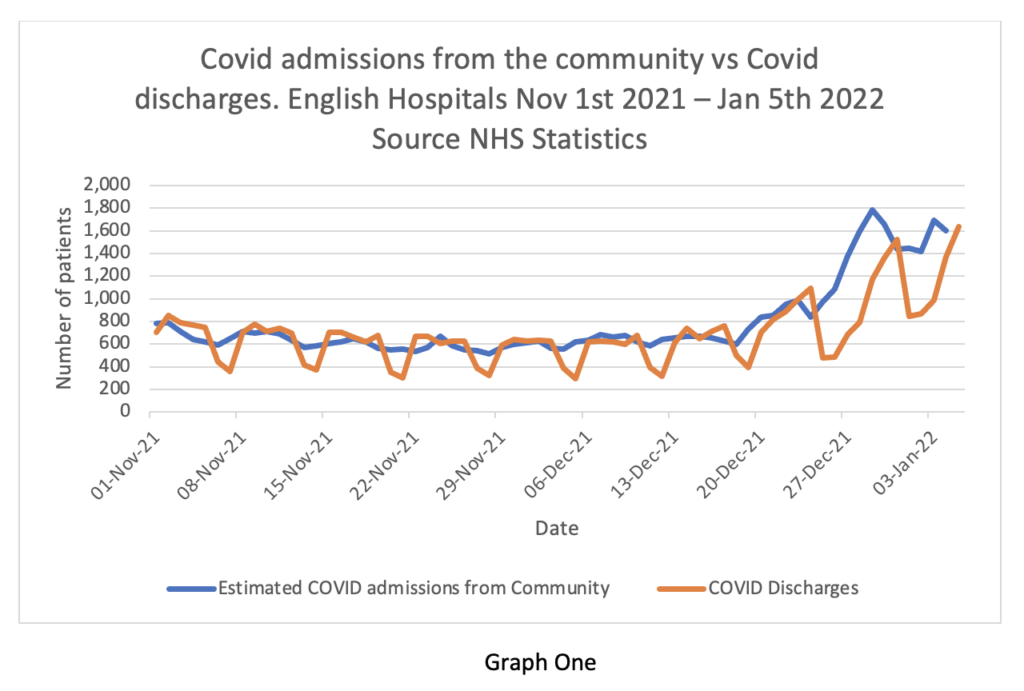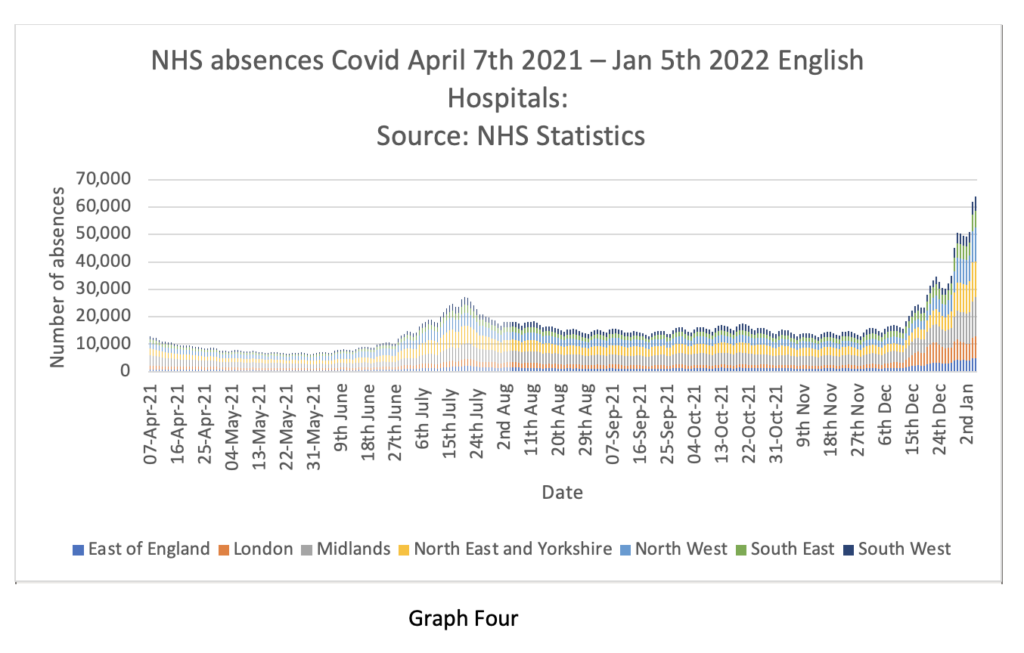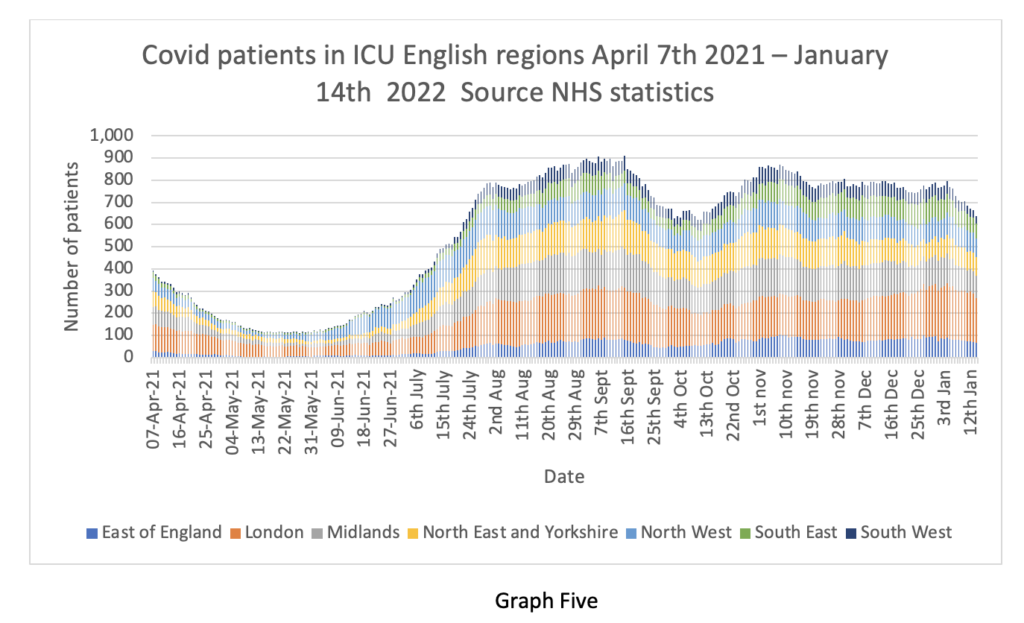
We’re publishing a guest post by our in-house doctor looking at the latest NHS data, including ICU data. Conclusion: Omicron hospital admissions in the community are declining and are unlikely to result in severe COVID-19.
Before diving into the numbers this week, I’d like to give a big shout out to Ms. Kate Josephs CBE, formerly the Director of the Cabinet Office Covid taskforce. According to the Telegraph, which broke the story of her leaving party, she “literally wrote the rules” in relation to societal restrictions.
Ms. Josephs took to twitter yesterday to apologise for attending a leaving drinks party on December 17th 2020, when she had been substantially responsible for putting the rest of the country under house arrest. She writes about being “truly sorry” for attending the event – she clearly means she’s sorry for being exposed.
The Telegraph has a helpful timeline graphic showing the dates of the many known social events in Whitehall against a backdrop of prevailing restrictions at the time. I had no idea being a civil servant was such fun! It is interesting that the parties all cluster round periods of maximum lockdown. The brief period in the summer of 2020 was a social desert for civil servants. Maybe they were all on extended holidays?
I love a good laugh, so I’d genuinely like to thank Ms. Josephs. I haven’t laughed so much since Dominic Cummings took a 20-mile drive to test his eyes. By being exposed, this formerly faceless apparatchik has performed a valuable public service. Her hypocrisy reveals the absurdity of what Lord David Frost calls “Covid Theatre” – pointless petty regulations enforced so that the Government appears to be “doing something”. If Kate Josephs really believed in December 2020 that covid was a serious threat to her health, would she have turned up to a drinking session in a cramped Whitehall office? I think not.
After a brief moment of levity, I turn to the stats. By now, we should be well into the ‘nailed on tsunami’ of cases which are overwhelming the NHS – but of course we are not. Covid admissions from the community are falling, particularly in London, where they have been on a downtrend since the turn of the year. This week we have the monthly data summary from the NHS. Graph One is instructive. It shows daily admissions (blue line) compared to daily discharges of Covid patients (brown line). The weekend effect of discharges is clearly visible, as is the lag over the festive period. But in general, discharges have kept up with admissions. As these two trends are in balance, there should be no problem.

Graph Two tells a different story. Although Covid admissions and discharges are in balance, the total number of patients testing positive in hospital rose in late December and is now plateauing. This is the figure of over 16,000 patients repeated nightly by the mainstream TV news channels. How can this be?

Graph Three explains. The Primary Diagnosis spreadsheet this week shows that the percentage of patients in hospital with incidental Covid is increasing. Graph Three shows the numbers for London. Over half of the 3,200 patients in London hospitals ‘with Covid’ are not actually unwell with Covid. This is most likely to mean that in-hospital spread is the main reason for increasing inpatient numbers, but this is of questionable clinical relevance, as most of these patients are asymptomatic.

Graph Four from the monthly summary packet shows the real reason for the dramatic headlines. At the end of December, the NHS sent over 60,000 employees home to self-isolate. The majority were asymptomatic with positive tests or had merely been in contact with a person testing positive. If testing of asymptomatic staff and patients ceased tomorrow, this ‘problem’ would evaporate overnight.

The ICNARC database this week contains some interesting information about recent ICU admissions. There has been virtually no information released in relation to the variants of Covid infecting ICU patients. Colleagues tell me that all ICU patients are tested centrally for Omicron, but this information is not passed back to clinicians.
ICNARC has compared the clinical characteristics of patients admitted to ICU since December 30th (mostly assumed to be Omicron) with the prior cohort (assumed mostly Delta). The detail is outlined on tables 17-19 on pages 49-51.
In summary, patients admitted since December 30th are less seriously ill than the prior cohort – their oxygen requirements and respiratory ratios are lower than the presumed Delta cohort. It is revealing that only 72% of the patients testing positive for Covid since December 30th had Covid as the primary reason for requiring critical care – before December 30th, this figure was 93%. In other words, a third of the patients in ICU ‘with COVID’ are not unwell with the virus.
This is good news. Although we don’t have precise information about variants, it’s reasonable to conclude that Omicron is very unlikely to cause serious illness. ICU numbers continue to fall (Graph Five) and are not really any worse than a normal flu season. Dr. Mikko Paunio, writing in these pages, has calculated the Infection fatality rate from Omicron is lower than seasonal influenza using high quality Danish data.

I have seen no commentary from senior NHS leaders on this encouraging news. Readers may wish to consider the following counterfactual: had the numbers shown Omicron to be worse than Delta, what sort of media coverage might the ICNARC data have received?
Minutes of the SAGE meeting 102 on January 7th reveal that all the points I have made today were recognised by SAGE last week. Lower severity of disease, lower rate of admissions, shorter hospital stays. SAGE also acknowledge in this meeting that societal restrictions are unlikely to have any effect on reducing hospitalisations at this stage. This was reinforced in a consensus statement from SPI-M-O.
Yet coverage in the media continues to emphasise the risks of removing lockdown measures. The Financial Times reports that “scientists warn on dropping England’s Plan B Covid curb too soon”. It’s puzzling that the FT journalists have read the same literature as I have and come to such radically different conclusions.
The Mail reports that Warwick University modellers predict an ‘exit wave’ in the summer with 10,000 daily hospital admissions. How they came to this conclusion is a mystery to me – for comparison, hospital admissions peaked on December 29th 2021 at 1,783.
At the risk of sounding flippant, had these numbers been analysed in connection with an upper respiratory virus in 2019 we would probably have concluded there was a nasty cold going around. In 2022 we look at the same data and conclude there is a deadly virus which will overwhelm the health service. Misinformation seems to spread even faster than Omicron.
Misinformation aside, one of the more troubling aspects of the recent past has been the distortion of normal medical practice. Drs Mordue and Shaw writing in these pages have contributed fine articles on this point – chapeau to both of them.
Readers interested in discovering how doctors are expected to behave may consult the General Medical Council’s document Good Medical Practice. I entirely endorse everything in this pamphlet and strive to demonstrate these principles in my professional practice.
Readers will discover many references to respecting patient choice, even if it is different from their doctor’s advice. Doctors are specifically prohibited from discriminating against such patients. There are cautions about assessing the risks of harm from treatment and explaining these before requesting consent. There are detailed injunctions around declaration of conflicts of interest, acknowledgment of mistakes and transparency around analysis of harms. There are explicit passages in relation to respecting colleagues and the rules around personal conduct.
Readers may wish to consider to what extent these rules have been followed by public health doctors in relation to lockdown advocacy and vaccine mandates. Where guidance has not been followed, readers may wonder why deviation from professional norms has been tolerated and even encouraged by non-medical managers and politicians.
The history of the NHS over the last three decades can be interpreted as a power struggle between unregulated professional managers and groups of clinicians for control and influence. The managers have overwhelmingly triumphed and Covid has been the apotheosis of that victory.
Medical practice is now subservient to demands of management. Doctors are becoming functionaries of the system rather than independent clinicians. Medicine is at risk of becoming a profession in name only, with a primary duty to the NHS as a whole, rather than to the patient as an individual. As Steve Baker MP has noted, the recent past has seen a fundamental reshaping of the relationship between the citizen and the state. Doctors are morphing inexorably into civil servants.
Party on.
It is my sincere desire to provide readers of this site with the best unbiased information available, and a forum where it can be discussed openly, as our Founders intended. But it is not easy nor inexpensive to do so, especially when those who wish to prevent us from making the truth known, attack us without mercy on all fronts on a daily basis. So each time you visit the site, I would ask that you consider the value that you receive and have received from The Burning Platform and the community of which you are a vital part. I can't do it all alone, and I need your help and support to keep it alive. Please consider contributing an amount commensurate to the value that you receive from this site and community, or even by becoming a sustaining supporter through periodic contributions. [Burning Platform LLC - PO Box 1520 Kulpsville, PA 19443] or Paypal
-----------------------------------------------------
To donate via Stripe, click here.
-----------------------------------------------------
Use promo code ILMF2, and save up to 66% on all MyPillow purchases. (The Burning Platform benefits when you use this promo code.)






Bad cold? FOAD. It is a cold.
I have some kind of thing right now that fits the description of covid. It’s not a cold. It’s not necessarily worse than a cold. For me the worst part is the dry cough which can be painful.
I have it right now and one of the symptoms has been a dry cough and itchy/tickling throat causing that cough. I have head and face congestion, almost like a sinus infection wants to start. It’s not bad though. I could physically go to work but since they know my wife is home sick with covid, they don’t want me to come in just yet, LOL.
I have covid right now and I would bet it’s the omicron variant. I had the first big variant to go through the U.S. in Dec of 2020. I have COPD and was pretty darn sick, bed ridden for two weeks, sick for three, fevers, and ended up with viral pneumonia in both lungs. I was in pretty rough shape. Well, I have covid again and this time its a piece of cake in comparison, like a head cold. What’s weird though is my vaccinated nurse wife is the one who brought it home and she’s had a rough go of it compared to me. She’s the healthy one too, well used to be anyways. I am worried about the vaccine she took. One of the two injections was from a Pfizer EN batch which is the worst and most toxic of the batches.